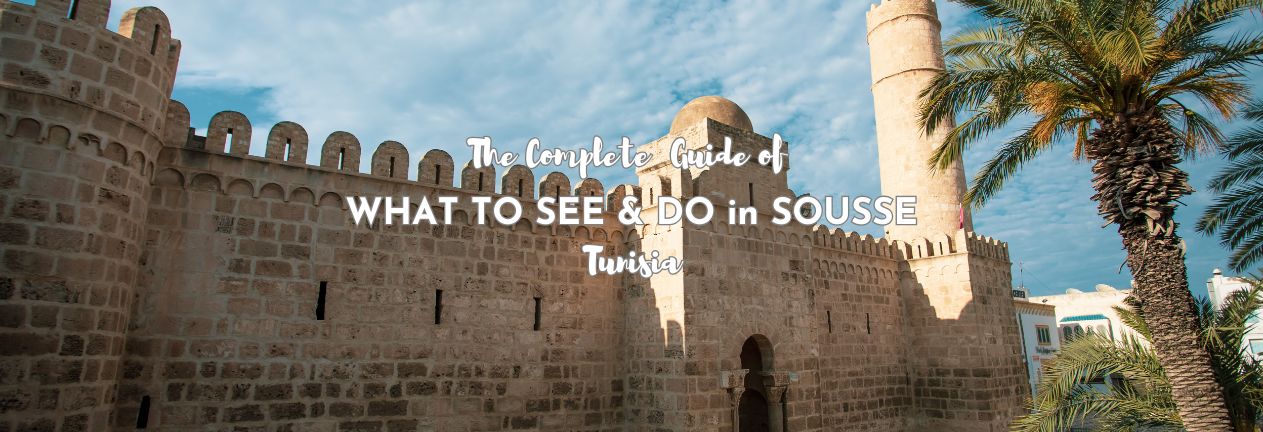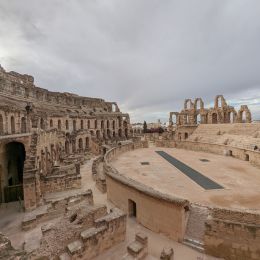If you’re planning to explore Tunisia’s coast, then Sousse should be on the list of places to visit. The city has a UNESCO-listed medina, sandy beaches, and a chilled-out out relaxed seaside feeling. A visit to Sousse means that you can explore the ancient Ribat in the morning, wander through the Medina and try mint tea before lunch, then wander along the corniche before you stop for dinner. Sousse also makes a superb base for exploring the amazing El Jem and interesting Kairouan. Plus, there’s Monastir and Port El Kantaoui close by. In this complete guide to Sousse, I’ll cover how to get here and around, the must-see sights, and the best beaches. I’ve got a section on where to eat and stay, and suggested itineraries too. Here’s my guide on what to see in Sousse.
THIS POST MAY CONTAIN COMPENSATED AND AFFILIATE LINKS MORE INFORMATION IN OUR DISCLAIMER
It’s easy to get to Sousse. There are great connections from Tunis, Monastir, and Hammamet. And once you’re here, there are some stunning sites to see, but not too many that mean you’ll exhaust yourself with culture. The beaches are great, and there are super options for resort hotels if you just want a day by the pool. And then when you’re ready to go again, the proximity to the incredible El Jem makes it impossible not to visit.
TOP THING TO DO
This incredible UNESCO World Heritage site is the only one of its kind and the chances are you’ll be one of the only people there. Think Rome’s Colloseum with no crowds. Don’t miss it.
Where is Sousse, Tunisia
Sousse is on Tunisia’s central coast, facing the Gulf of Hammamet. It’s about 88 miles (142 kilometers) south of Tunis, which makes it an easy two-hour drive down the A1 in normal traffic. Intercity trains connect Tunis and Sousse in around 2 hours and 30 minutes, depending on the service.
The closest airport to Sousse is Monastir Habib Bourguiba Airport –it’s about 35–45 minutes from Tunis to Monastir, which is about 12 miles/20 kilometers from Sousse. There’s a Metro Sahel light rail stop at the station, which gets you to Sousse quickly and cheaply. Here’s my guide on going between Monastir and Sousse.
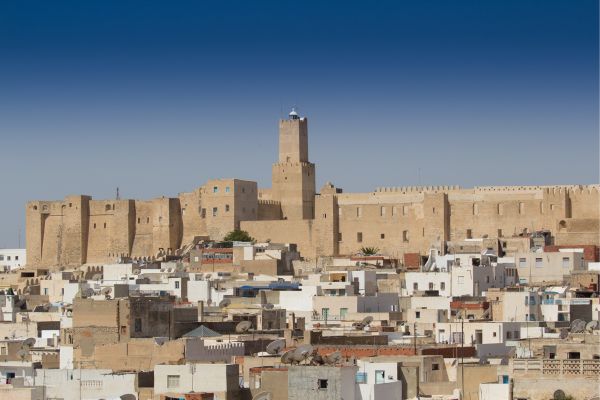
How to Get to Sousse
Getting to Sousse is straightforward, whether you fly into the closest international airports or are transferring overland. There’s more on the different forms of transport in Tunisia in my guide here.
Nearest Airports and Flying to Sousse
The closest airport is Monastir Habib Bourguiba (MIR) or Enfidha–Hammamet (NBE). MIR is just 12 miles (20 kilometers) from Sousse, and there’s a stop at the airport that’s on the Metro Sahel line. Alternatively, private transfers take 25–40 minutes. NBE is 28 miles (45 kilometers) away, and that journey takes about 35–50 minutes by taxi, depending on traffic.
My guide on going from Tunis to Sousse with all the options is here.
PRACTICAL TRAVEL TIPS
- 🛡️ Get Travel Insurance: Civitatis includes medical expenses, repatriation, theft, luggage delays. No deductibles or upfront payments. Get a quote here.
- 💰 Read about the Currency in Tunisia and ATM fees.
- 🔌 Check out Tunisia’s plug, socket & power situation.
- 📶 Internet, maps and data on the go. eSims for Tunisia
Taking the Train to Sousse
Sousse is on Tunisia’s main north–south rail line, with direct SNCFT trains from Tunis taking about 2 hours to 2 hours 30 minutes. You’ll arrive at Gare de Sousse, which is a 10–15 minute walk to the medina. The Metro Sahel platforms for Monastir and Mahdia are next to the main SNCFT lines.
Trains are generally comfortable but can sell out at peak times; you’ll need to keep your ticket for onboard checks and stow your luggage above or between back-to-back seats.
Taking a Bus to Sousse
Intercity coaches connect Sousse with Tunis, Monastir, Kairouan, Sfax, Mahdia, and beyond. From Tunis, frequent departures run from the southern bus station (Bab Alioua) with a ride time of about 2.5–3 hours, depending on traffic and stops. Buy tickets at the counter on the day; go earlier for weekends and holidays. Coaches are air-conditioned, with numbered seats and underfloor luggage; keep small bags with you. Arrive 20 minutes early to board. In Sousse, most services set down near the centre, a short taxi ride to the medina. You’ll need cash for tickets for buses and louages, so check out my post on cash in Tunisia here.
Taking a Shared Minibus – a Louage to Sousse
Louage are shared minibuses that run fixed routes and depart when all seats are sold. They’re often the quickest budget option between cities and are a common feature here in Tunisia. From Tunis, look for services signed for Sousse at the Station Louage Moncef Bey, and you’ll find it near the Barcelona train station.
You pay in cash at the ticket window or to the dispatcher and keep the ticket. Fares are fixed, there’s no haggling, and luggage space is limited; you might have to pay extra for large bags. Vans are basic but fast, stopping only for essentials. In Sousse, drop-off is at the Al Lawajat Louage station, a short taxi ride from the medina.
Driving a Rental Car to Sousse
From Tunis, follow the A1 south to Sousse; it’s a straightforward two-hour run if you have good traffic. There are tolls en route. There are frequent fuel stations. Once you arrive in Sousse, the traffic is more congested by the medina and corniche, although if you arrive outside of peak times – 08:00–10:00 and 16:00–19:00 you’ll encounter less traffic.
If you’re staying in the medina, then use marked and paid-for parking lots or guarded street parking. Do NOT leave anything in view in the vehicle. Speed checks are common, so stick to the limit and always carry your passport and vehicle documents. My guide to International Driver Permits is here (it’s detailed for Japan, but the concept is exactly the same)
Getting Around Sousse
All the places that we visited in Sousse, we walked to. In the medina, there’s no option other than walking, as the alleyways are narrow. If you’re heading to Monastir or Mahdia, then you can take the Metro Sahel, a taxi, or a louage.
If you’re planning several day trips, then a rental car might make sense. But a guided tour comes with a guide.
Metro Sahel
You won’t really use this for getting around Sousse, but it’s a handy connector to Monastir and Mahdia. There are frequent trains during the day, and it’s the most convenient way to get to the airport at Monastir (there’s even an airport station for it). The timetable for the Metro Sahel is here.
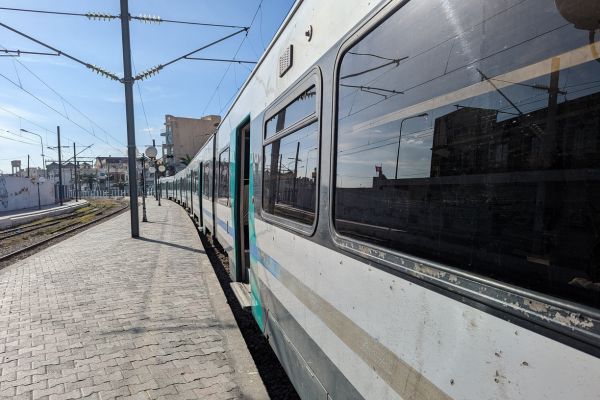
Tickets are cheap, buy at the station window, or use the machines. Remember to keep the tickets for checks, and you’ll need them to get through the barrier at your destination.
Taxis in Sousse
Taxis in Sousses are yellow and metered. So make sure the driver turns on the meter before you set off. Rates are higher at night and on public holidays. You’ll need to pay cash, and as ever, keep small change for these rides.
Why come to Sousse?
Sousse is a great combination city to visit. There’s a UNESCO-listed medina here, the Ribat is stunning, and then you’ve got the beaches and resort hotels for a little luxurious comfort. When you’re ready for a little more culture, you’re close to El Jem, Kairouan, and Monastir. Added to that, great transport links and a pleasant climate, and some fabulous food options too.
Check out my guide to visiting Kairouan here.
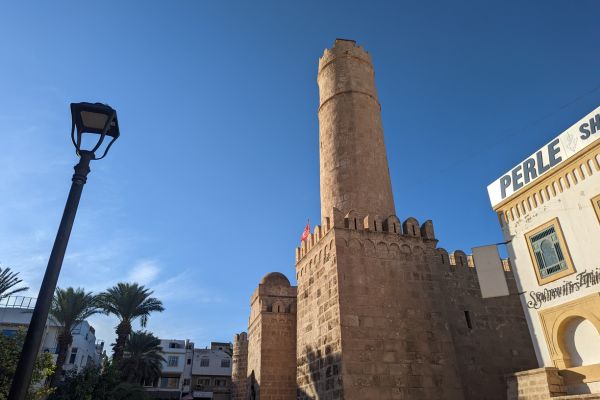
What to See and Do in Sousse
There’s not an entire route march of things to do in Sousse, but what’s here is interesting and should keep you entertained for two or three days.
Explore the Medina in Sousse
Sousse’s medina has been a UNESCO world heritage site since 1988, and as well as being somewhere that people live, (and you can stay here too, the Dar Antonia inside the medina is a fabulous choice, with a lovely rooftop plunge pool)
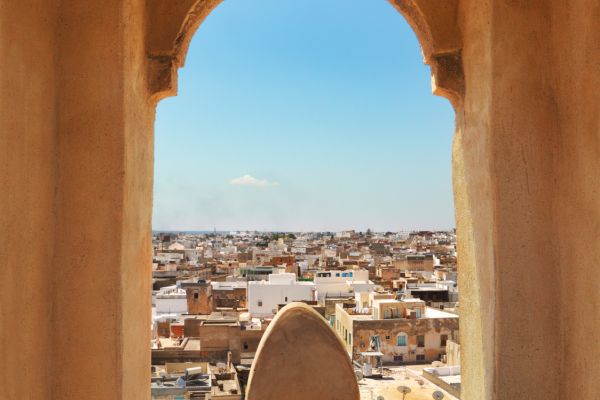
If you’ve already been to the medina in Tunis, then this is a completely different feeling. It’s a lot quieter; fewer tourists venture here. That said, you’ll still find ceramics, olive-wood carvings, leather slippers, and mosaic sellers and, of course, the ubiquitous touts. Don’t forget to bargain, at least a little, and if the pricing feels off, then it probably is, so walk away.
Visit the Great Mosque
A cornerstone of 9th-century Aghlabid architecture, the Great Mosque sits just inside the medina near the Ribat, which was built 30 years earlier. Its fortress-like walls and large courtyard indicate how coastal mosques doubled as refuges. Non-Muslims are usually allowed into the courtyard and porticoes, not the prayer hall. You must dress modestly, with shoulders and knees covered; women should carry a scarf; and everyone removes their shoes. There’s a small fee to enter, which you’ll pay at the wooden ticket booth close to the entrance.
Explore Sousse’s Ribat
The oldest building in Sousse, the Ribat, was built around 820 AD. It’s part fortress, part monastery, and dates from the Aghlabid era. Entrance fees are 8 TND, and it’s open from 08:00 until 17:00. Climb the watchtower in the corner for the best views of the city and the sea, and walk around the ramparts for a closer look.
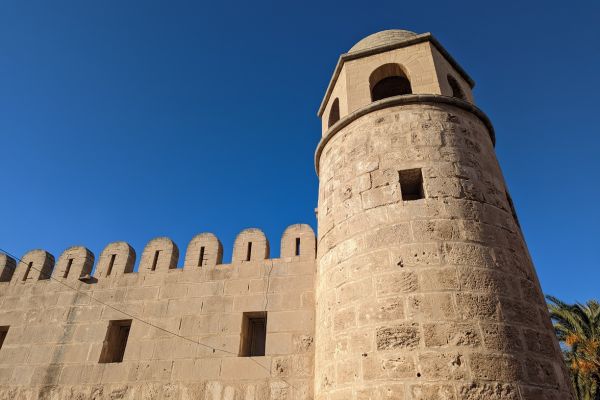
Visit the Sousse Archaeological Museum
Set inside the Kasbah above the medina, this museum has one of Tunisia’s great Roman mosaic collections, second in size only to the Bardo in Tunis. You’ll find galleries covering Punic, Roman, and early Christian finds, but the top things to see are the enormous sea scenes and mythological panels that came from old coastal villas.
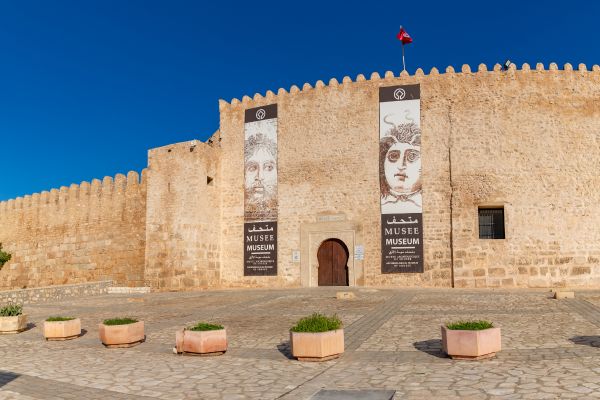
The museum is open from 09:00 until 17:00 and closed on Mondays. Tickets are 10 TND per adult.
Explore the Museum Dar Essid
Privately owned until the 1990’s this is a beautifully preserved traditional townhouse.
The Dar Essid Museum is set up to display everyday objects from the recent past. There’s a central tiled courtyard, carved ceilings, and the climb to the rooftop tower gives fabulous views. It will cost you 5TND to enter and a further 1 TND to take photos. The museum is open from 10:00 to 18:00 and closed on Sundays.
Bab El-Gharbi
The Bab El-Gharbi is the western gate of the medina, where thick walls and a squat arch formed part of Sousse’s old defenses. For its age (it’s been here since about 900 AD), it’s amazingly well preserved.
Walk the Corniche, aka Sousse’s Boardwalk
Sousse’s corniche runs alongside Boujaffar Beach, a flat, palm-lined promenade to the resort hotels. We walked the corniche and then onto the sand back to the Marhaba Club hotel. You can follow the boardwalk, which runs alongside Avenue Heid Chaker, for about 16 kilometers (1 mile), and then you’ll have to go inland, behind the Riadh Palms and Mövenpick hotel, or walk along the sand.
Port El Kantaoui Marina
About 10 kilometers (6 miles) north of central Sousse is Port El Kantaoui. It’s a tourist marina, cafés, restaurants, and a lively nightlife. It’s in the “tourist zone”, so it’s here that you’ll find boat trips, cruises, and something more of a westernised approach to dining and shopping – perhaps even price tags on items. There’s also a dive center here. It’s about 20 minutes by taxi from central Sousse.
Best Beaches in and near Sousse
You’ve got two main options when it comes to beaches. The public beach that’s close to the center, and that runs alongside the boardwalk/corniche, but you’ll need to head north towards the resorts that start at the Riadh Palms and run pretty much up to Port El Kantaoui for sun loungers, beach bars, and facilities.
Boujaffar Beach
This is Sousse’s city beach, it runs alongside the corniche and is within easy walking distance of the medina. There’s usually a tourist train that runs along here in season, horses and carriages ply their trade along the avenue backing the beach, and it’s a family area, with a gently sloping beach, and you’ll find vendors renting loungers too.
Port El Kantaoui Beach
Once you get to the end of where Avenue Hedi Chaker runs parallel to the beach, you’ve hit the resorts and the tourist zone. These resort hotels generally have cleaner sand, organised sections, and facilities like beach bars and cafes. You can walk here – it’s about a mile (1.6 kilometers) from the start of Boujaffar Beach, or take a taxi. The resort beaches run all the way up to the Port El Kantaoui marina.
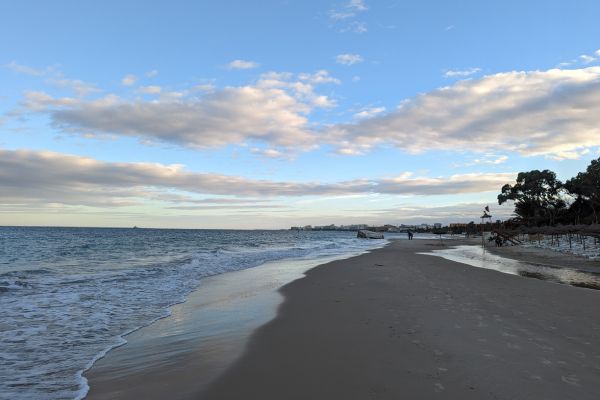
What and where to eat in Sousse
Tunisia’s coastal cooking combines olive oil, tomatoes, spices, and seafood, with the heat of harissa (if you want it). In Sousse, that translates to Brik that’s fried to order, couscous with fish or lamb, and market-fresh produce, all backed up by amazing French influence bread and pastry.
You’ll want to add these to your list of what to try when you’re in Sousse:
- Brik: paper-thin pastry wrapped around egg and tuna, it has a crisp outside and a runny yolk if you time it right. Don’t burn your mouth!
- Couscous: Tunisia’s national staple; versions here in Sousse come with fish or seafood.
- Ojja: tomato-chilli stew with eggs, sometimes merguez (spicy sausage).
- Lablebi: chickpea soup, great for cooler days.
- Bambalouni: hot, sugar-dusted doughnuts as a street-sweet.
For drinks and snacks: You’ll get great views over the harbour and the medina at the Beb Al Medina Café. Offerings here are simple and not overpriced. Head into the Medina and the Dar Lella Khadija, for mint tea inside a glorious restored townhouse.
For more of a meal, Head to El Soffra Chez Fredj, where there are traditional meals at reasonable prices, it’s good for couscous and daily specials. Also near the medina, the Restaurant du Peuple is a good option, with reasonably priced Mediterranean and Tunisian staples.
How long to spend in Sousse
If you’re not basing yourself at a beach resort (I’m not judging, we did and enjoyed the best of both worlds), then two to three days in Sousse is a good amount of time. You’ll be able to see the UNESCO-listed medina, the Ribat and the Great Mosque, explore the Archaeological Museum, or visit the Museum Dar Essid. And that leaves you plenty of time for one or two-day trips. (You can combine several of them into one long day!) Sousse is a great place to base yourself and head out on day trips to El Jem or Kairouan. And, yes, you must. El Jem specifically is amazing. My guide to El Jem is here.
When to visit Sousse
Sousse is warm most of the year. April to June brings sunny days and mild evenings—great for sightseeing and swims without furnace heat. July and August are hot and busy, with strong sun and fuller beaches; plan early starts and long siestas. September and October stay warm, with calmer seas and fewer crowds. November to March is cooler and changeable; some beach services scale back, but sights are quieter. During Ramadan, hours for museums and restaurants can shift, and Fridays may have shorter opening times—plan morning visits and check same-day schedules locally.
Where to Stay in Sousse
Either stay right smack bang in the middle of the Medina (but afford yourself an amazing view from the rooftop) or stay in one of the beach resort hotels.
Stay at the Marhaba Club Sousse for a good beach, pool, and entertainment option. It’s a beachfront base with pools, gardens, and nightly entertainment. Rooms here are simple but practical; the food was great, with lots of different Western options, but a great variety of Tunisian options too. We stayed here for a week and weren’t bored with the food.
Or opt for the Dar Antonia in the heart of the medina with a rooftop plunge pool. It’s a fabulous character stay inside the medina, with tiled rooms like these around a courtyard and a rooftop plunge pool. Eat your breakfast on the terrace, just steps from the souks. Opt for the room with the amazing tub.
TUNISIA TRAVEL RESOURCES
AIRPORT TRANSFERS
24/7 pickup & drop off. Trusted, local English speaking drivers. Prebook & prepay online with cards.
Book a Transfer
HOTELS AND APARTMENTS
See choices here
Sea view rooms? Budget rooms? Need a washing machine? The best choice of hotels & apartments.
TOURS & ATTRACTIONS
Most excursion choices, small group tours, skip-line tickets, free cancellation and top local guides.
Top options here.
CAR RENTAL OPTIONS
Choose cars here
Best choice of vehicles, automatics, large or small cars, child seats. Book early for more options.
Final Words on Visiting Sousse, Tunisia
You don’t need much of a plan when visiting Sousse; it’s a pretty easy city to explore, much of it on foot, but make time to come to the Medina, explore the Ribat, and the Great Mosque. Then explore the boardwalk and beaches, which are really quite lovely. Don’t miss out on a day trip to El Jem or Kairouan, or both.
ASocialNomad is a participant in the Amazon Services LLC Associates Program, an affiliate advertising program designed to provide a means for sites to earn advertising fees by advertising and linking to amazon.com, amazon.co.uk, and amazon.ca. Amazon and the Amazon logo are trademarks of Amazon.com, Inc. or its affiliates. As an Amazon Associate, I earn from qualifying purchases.
